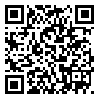Volume 18, Issue 71 (2021)
LIRE 2021, 18(71): 29-32 |
Back to browse issues page
Download citation:
BibTeX | RIS | EndNote | Medlars | ProCite | Reference Manager | RefWorks
Send citation to:



BibTeX | RIS | EndNote | Medlars | ProCite | Reference Manager | RefWorks
Send citation to:
mohammed ebrahimi jahromi Z, nayeri fallah S N. The current errors source of beginner, intermediate and advanced Persian learners. LIRE 2021; 18 (71) :29-32
URL: http://lire.modares.ac.ir/article-41-56214-en.html
URL: http://lire.modares.ac.ir/article-41-56214-en.html
1- , z_mebrahimi@yahoo.com
Abstract: (1593 Views)
The present study has formed in order to determine the current errors source of Persian leaners at beginner, intermediate and advanced levels. this survey tries to give answer to this question: From what source do current errors and mistakes of Persian leaners originate at beginner, intermediate and advanced levels? To this end, some compositions were prepared from Saadi Foundation Corpus in this address: http://sfcorpus.ir. These data were recorded by foundation instructors regarding years (2015-16) on website and
they belong to Persian learning courses held for Arab, Chinese, Pakistani, Indian and Turkish language learners at six levels (Basic, pre-intermediate, intermediate, upper-intermediate, advanced and upper- advanced). Given research subject, 210 compositions, belonged to 5 Persian-learners from Saudi Arabia, China, Pakistan, India and Turkey were elected in several subjects where each Persian learner gave 14 sheets with totally 70 sheets at any learning- level (Beginner, intermediate and advanced). Then, data were analyzed by descriptive method based on Error Analysis Scale (Keshavarz, 1994) and the acquired results were presented both qualitatively and quantitatively. The given findings derived from this analysis showed that the current errors of Persian learners originate from extra lingual source at beginner level and learning strategy is the factor for current error for Persian learner at intermediate level. Finally, the current errors of Persian learners are related to learning texture at advanced level. The analytical results can be addressed by instructors, authors and educational planners for non-Persian speakers so that to recognize better weak points of Persian learners to select appropriate teaching technique and provide educational textbooks.
they belong to Persian learning courses held for Arab, Chinese, Pakistani, Indian and Turkish language learners at six levels (Basic, pre-intermediate, intermediate, upper-intermediate, advanced and upper- advanced). Given research subject, 210 compositions, belonged to 5 Persian-learners from Saudi Arabia, China, Pakistan, India and Turkey were elected in several subjects where each Persian learner gave 14 sheets with totally 70 sheets at any learning- level (Beginner, intermediate and advanced). Then, data were analyzed by descriptive method based on Error Analysis Scale (Keshavarz, 1994) and the acquired results were presented both qualitatively and quantitatively. The given findings derived from this analysis showed that the current errors of Persian learners originate from extra lingual source at beginner level and learning strategy is the factor for current error for Persian learner at intermediate level. Finally, the current errors of Persian learners are related to learning texture at advanced level. The analytical results can be addressed by instructors, authors and educational planners for non-Persian speakers so that to recognize better weak points of Persian learners to select appropriate teaching technique and provide educational textbooks.
Article Type: Original Research |
Subject:
Farsi language
Received: 2018/12/31 | Accepted: 2021/04/26 | Published: 2021/07/22
Received: 2018/12/31 | Accepted: 2021/04/26 | Published: 2021/07/22
Send email to the article author
| Rights and permissions | |
 |
This work is licensed under a Creative Commons Attribution-NonCommercial 4.0 International License. |









